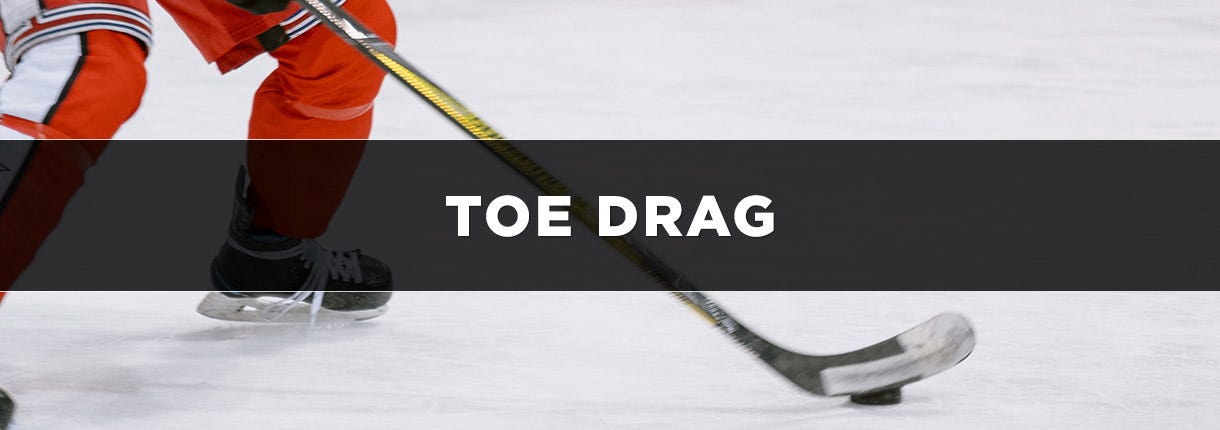A Guide to the Hockey Toe Drag

If you’re looking to up your game on the ice and leave defenders in the dust, a skill that’ll help is the toe drag hockey move. Mastering a hockey toe drag can take your game to new heights. Keep reading to learn what a toe drag is and how to toe drag effectively and for tips on practicing and perfecting this essential move.
In this article, we’ll cover:
What is a Toe Drag in Hockey?
The toe drag is an offensive move used to dodge defenders while maintaining control of the puck. It involves using the top hand on your stick to pull or “drag” the puck across your body with precision and finesse.
To execute a successful toe drag, you’ll need excellent puck-handling skills and hand-coordination. Specifically, you want firm control from your bottom hand while you apply pressure with the top one. This combination allows for quick changes in direction and can leave opponents guessing where you’re heading on the ice and with the puck.
Is a Toe Drag a Deke?
Many new hockey players wonder if a toe drag can be considered a deke. To understand this, you must first know what constitutes a deke in hockey.
A deke is any move that involves faking out an opponent with body movements, stickhandling, or puck control. It’s designed to create space and opportunities for scoring or passing by confusing and evading defenders.
In short, yes, the toe drag qualifies as a type of deke since it involves both stickhandling skills and deceptive body movements to bypass opponents on the ice.
Read more about hockey dekes in our Hockey Deke Guide.
How to Toe Drag in Ice Hockey
The toe drag can help you maintain puck control, deceive defenders, and create scoring opportunities. Fortunately, learning to execute the perfect toe drag isn’t hard when you have the right tips.
Step 1: Get Comfortable with Your Stickhandling
Before attempting a toe drag, you must be comfortable with basic stickhandling techniques. You can improve your stickhandling ability with a bit of practice. A simple, effective stickhandling drill involves moving the puck back and forth using both your top and bottom hand while controlling the puck when skating at various speeds.
Step 2: Position Your Body Correctly
To begin the toe drag, position yourself so your body is slightly angled toward the defender or opponent you want to evade. Lower your center of mass by flexing joints to give more room for maneuverability.
- Bend your knees: Keep a low center of gravity by bending your knees slightly throughout the entire movement.
- Puck placement: Place the puck near your front foot (the one closest to where you’re trying to go) before starting the move.
- Grip: Hold your stick firmly but not too tightly – remember that flexibility is key when executing quick movements like a toe drag.
Step 3: Execute the Toe Drag Move
Moving through these steps quickly will ensure success in performing a smooth toe drag:
- Pull back on your top hand and push forward with the bottom hand to cause the blade of your stick to roll over the puck so you can pull it toward your body.
- Use the toe of your blade as you pull the puck in to maintain control and guide its movement.
- Get control of the puck by rolling it back onto the flat part of your blade. Then quickly accelerate past your opponent.
How Do I Get Better at Toe Drag?
You need to practice regularly and focus on the fundamentals to improve your toe drag skills. The following tips will help enhance your toe drag technique and become more confident executing the move during games.
Start with a Proper Grip
The bottom palm should be set at the midpoint of your stick to allow for better control when performing a toe drag.
Continue Improving Your Stickhandling Skills
Because a successful toe drag requires excellent stickhandling abilities, make sure to practice drills that focus on quick movements and maintaining puck control.
Use Visual Cues to Improve Timing
Timing is crucial with the toe drag – watch videos of professional players doing toe drags or ask an experienced teammate or coach to help you perfect your technique.
Tips for Practicing Toe Drags:
- Mirror Practice: Stand in front of a mirror and perform slow-motion toe drags without skates on to get familiar with body positioning.
- Dryland Training: Practice off ice using a ball or puck designed specifically for dryland training.
- Incorporate Obstacles: Set up cones or other obstacles as defenders while simulating game situations.
- Practice with Different Speeds: Vary the speed of your toe drags to develop versatility and adaptability during games.
Strengthen Your Wrist and Forearm Muscles
A strong wrist snap is crucial for a successful toe drag. Incorporate exercises like wrist curls, grip strengtheners, or resistance bands into your workout routine to enhance your wrist strength.
Analyze Your Performance
Film yourself practicing toe drags and look at the footage to try finding areas or form that need improvement. You can also ask for feedback from coaches or teammates who can help you improve your technique.
Hockey Toe Drag FAQ
How do you teach a toe drag in hockey?
To teach a toe drag in hockey, use the following tips:
- Start with stationary practice and have players put their stick on the ice and the puck at their side.
- Have them pull the puck toward their body using only the toe of their blade.
- As they become more comfortable with this motion, have them try doing the move while going forward slowly.
- Gradually increase speed during practice drills or scrimmages until players feel ready to incorporate their new move into game situations.
How do you defend a toe drag in hockey?
Anticipation and maintaining proper positioning are key to defending against a toe drag. Keep these tips in mind when facing an opponent who’s about to attempt a toe drag:
- Maintain good gap control between yourself and your opponent. This gives you enough time to react if they attempt a deke like the toe drag.
- Focus on their chest rather than following the puck to help maintain proper positioning.
- Poke check strategically – aim for where you anticipate your opponent’s next move to be instead of lunging blindly for where they currently are.
- If possible, force your opponent toward less dangerous areas on the ice by angling them away from high-scoring zones.
What is the best hockey curve for toe drags?
The best hockey curve for toe drags is subjective and depends on an individual player’s preference. However, a stick with a more open face and deeper curve may provide better puck control during toe drags.
What is a backhand toe drag?
A backhand toe drag is similar to the standard forehand version but executed using the backside of your blade. This hockey move can be incredibly deceptive because it requires less obvious movement from your hands or arms, making it harder for defenders to anticipate.
Want to learn more about hockey moves? Read our article "7 Hockey Moves Every Player Should Know" here.
Equip Yourself with the Best Skates to Master Your Toe Drag
Now that you understand the hockey toe drag and know how to improve your skills, having the right hockey gear is essential.
Your equipment can make all the difference on the ice – and HockeyMonkey offers top-of-the-line skates to help you glide effortlessly as you perform your toe drags. We also have the best sticks on the market. Don’t settle for less when it comes to your equipment. You’ll find everything you need at HockeyMonkey – browse our full selection of hockey skates and more today.











